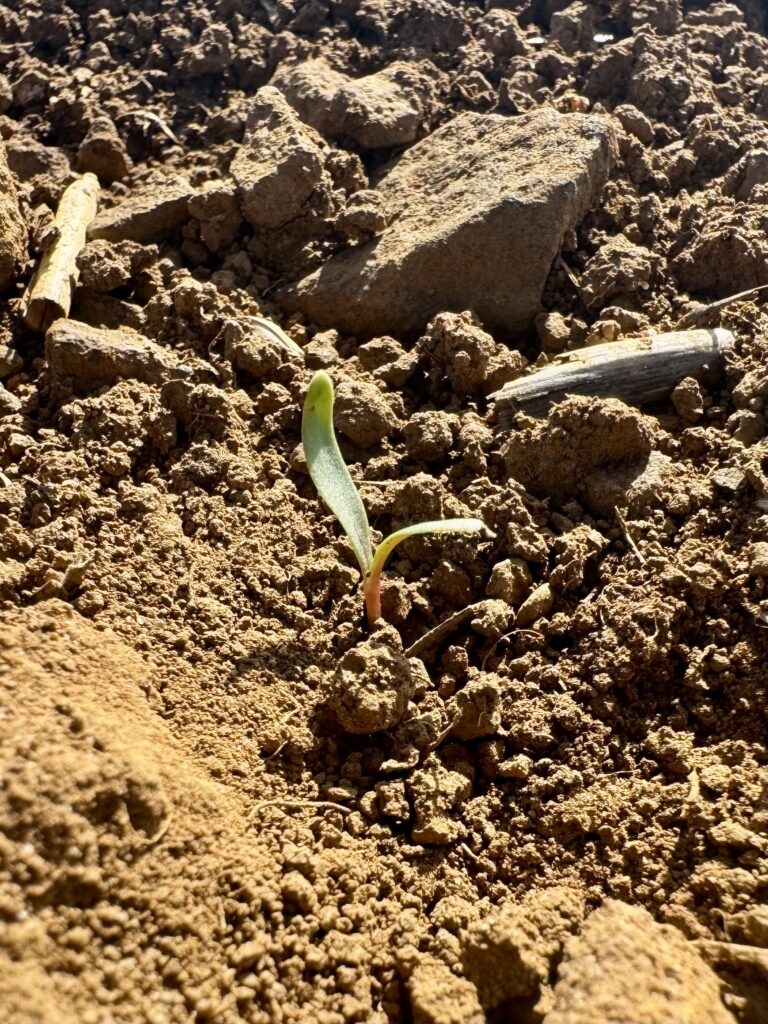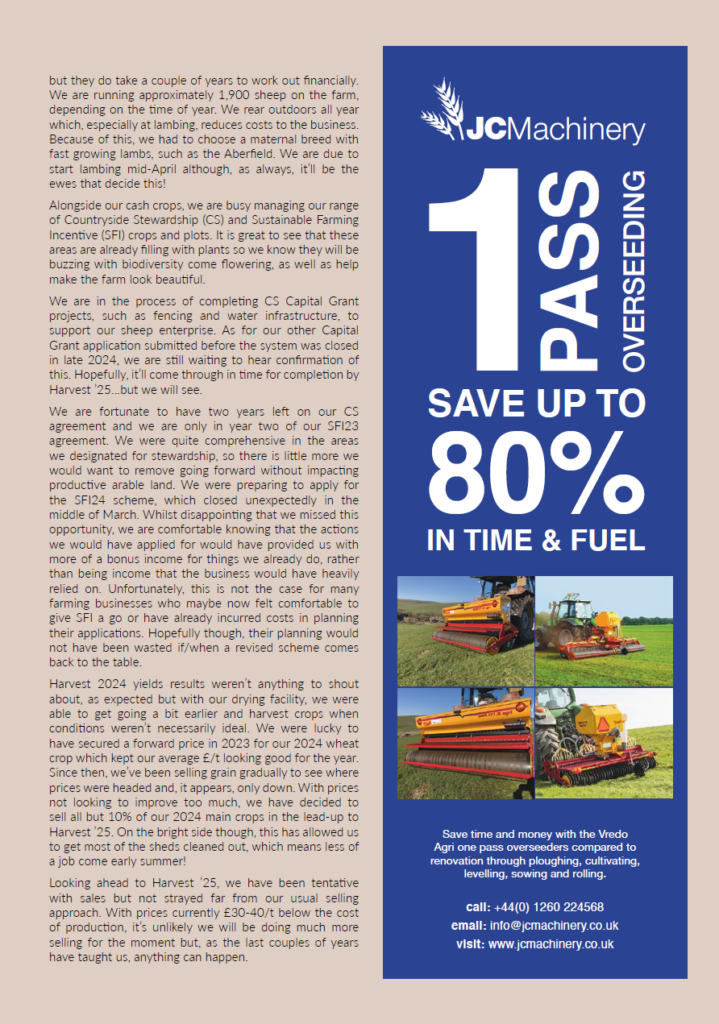Hello! I am Zoe, the Assistant Farm Manager on a large arable and sheep farm on the Lincs/Leics border.
As we see the end of the drilling season Spring ‘25 has been kind to us, leaving me feeling slightly unsettled with a thought of “what will Mother Nature do next?!”. We have made good progress so far; sugar beet is emerging, the peas are chitting (no frosts, please!), the oats are popping up in rows and land is cultivated ready for maize drilling. Our winter crops are also doing well, albeit a bit behind, with this year’s fungicide programme ready to roll and our OSR already in flower (yes, we are still sticking with OSR!).
Our spring drilling has been completed with the John Deere 8RX and Horsch Avatar, focusing on minimising compaction with machinery weight distribution and reduced cultivation to conserve soil moisture. Where cultivations were required, such as after cover crops or the grazed fodder beet, the 8RX and 8R have been pulling a Vaderstad TopDown, but we did demo a Vaderstad Carrier with CrossCutter Discs which did a good job, and quickly.
Whilst we have had good weather to get on with spring operations, with the forecast looking dry over the next couple of weeks, dare I whisper, “we could do with some r***”. Not only will it help to get drilled crops growing, but it will aid in washing down the granular N and provide some further cultivation.
We do a mix of liquid and granular N, both for storage purposes as we have liquid tanks and grain is still sitting in stores, but also for availability of N to the crop, A) to get it going and B) to keep it going. We have been increasing our use of muck and digestate because of their nutrient content, cost and availability, as well as to improve our carbon footprint with the reduced need for inorganic N. We’ve started exploring carbon opportunities so we will have to see how well this performs as a future source of income.
We try to run as broad a rotation as possible on the farm, accepting that whilst some crops may not provide the most attractive margins, they do still have a role to play. We have several farmyards which provide space for storage for our variety of crops and our grain drying facility allows for flexibility during harvest. Our rotation includes winter cereals, winter beans and OSR, along with spring cereals, sugar beet and maize. We also integrate options such as GS4 and AB15/NUM3 under stewardship into the rotation.

Sheep were introduced to the farming operation a couple of years ago to improve the arable enterprise through grazing and the return of organic matter, plus they offer an opportunity for a diversified income – they’re a useful tool in the business but they do take a couple of years to work out financially. We are running approximately 1,900 sheep on the farm, depending on the time of year. We rear outdoors all year which, especially at lambing, reduces costs to the business. Because of this, we had to choose a maternal breed with fast growing lambs, such as the Aberfield. We are due to start lambing mid-April although, as always, it’ll be the ewes that decide this!
Alongside our cash crops, we are busy managing our range of Countryside Stewardship (CS) and Sustainable Farming Incentive (SFI) crops and plots. It is great to see that these areas are already filling with plants so we know they will be buzzing with biodiversity come flowering, as well as help make the farm look beautiful.
We are in the process of completing CS Capital Grant projects, such as fencing and water infrastructure, to support our sheep enterprise. As for our other Capital Grant application submitted before the system was closed in late 2024, we are still waiting to hear confirmation of this. Hopefully, it’ll come through in time for completion by Harvest ’25…but we will see.
We are fortunate to have two years left on our CS agreement and we are only in year two of our SFI23 agreement. We were quite comprehensive in the areas we designated for stewardship, so there is little more we would want to remove going forward without impacting productive arable land. We were preparing to apply for the SFI24 scheme, which closed unexpectedly in the middle of March. Whilst disappointing that we missed this opportunity, we are comfortable knowing that the actions we would have applied for would have provided us with more of a bonus income for things we already do, rather than being income that the business would have heavily relied on. Unfortunately, this is not the case for many farming businesses who maybe now felt comfortable to give SFI a go or have already incurred costs in planning their applications. Hopefully though, their planning would not have been wasted if/when a revised scheme comes back to the table.
Harvest 2024 yields results weren’t anything to shout about, as expected but with our drying facility, we were able to get going a bit earlier and harvest crops when conditions weren’t necessarily ideal. We were lucky to have secured a forward price in 2023 for our 2024 wheat crop which kept our average £/t looking good for the year. Since then, we’ve been selling grain gradually to see where prices were headed and, it appears, only down. With prices not looking to improve too much, we have decided to sell all but 10% of our 2024 main crops in the lead-up to Harvest ’25. On the bright side though, this has allowed us to get most of the sheds cleaned out, which means less of a job come early summer!
Looking ahead to Harvest ’25, we have been tentative with sales but not strayed far from our usual selling approach. With prices currently £30-40/t below the cost of production, it’s unlikely we will be doing much more selling for the moment but, as the last couples of years have taught us, anything can happen.


